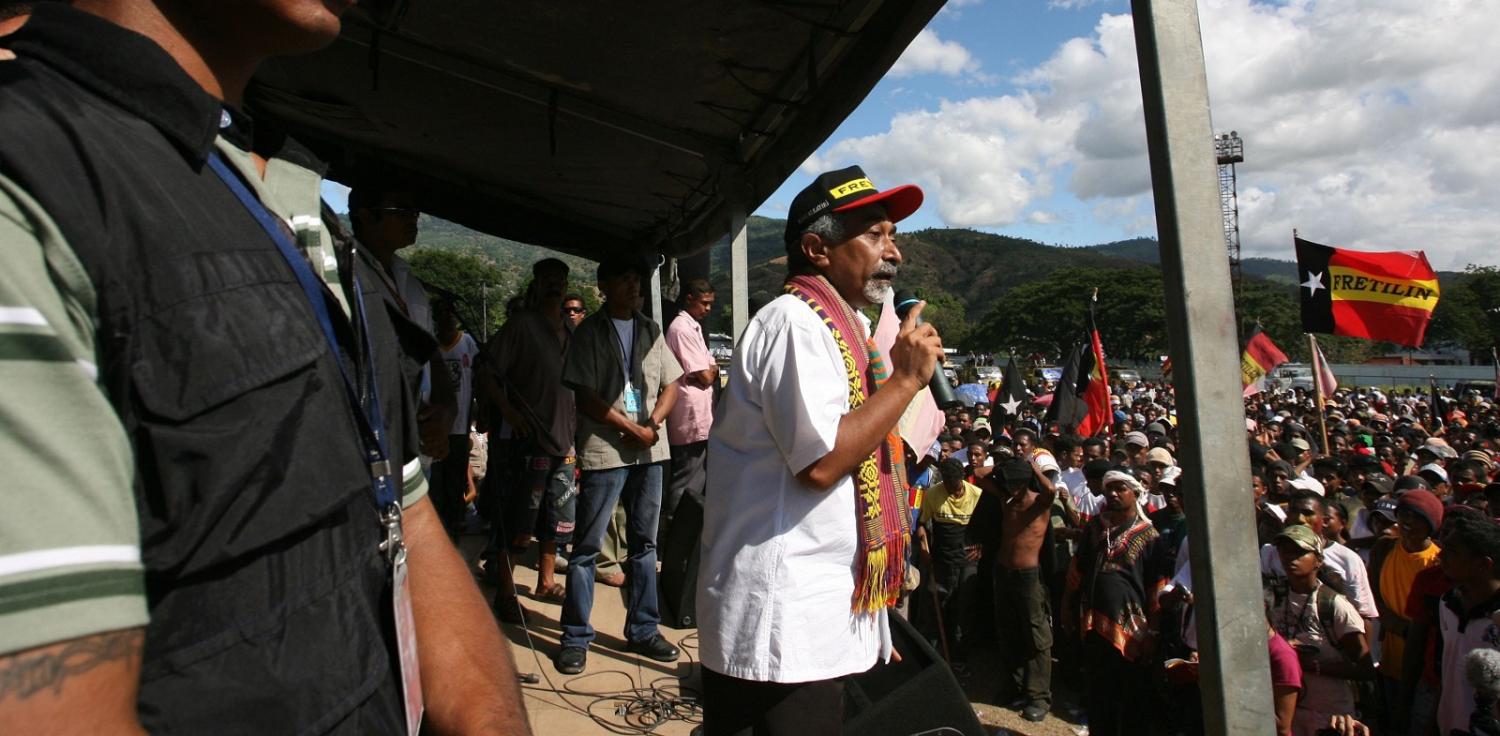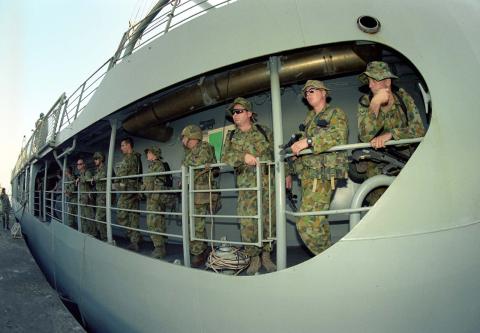Almost two months since the 22 July election, a new government will be sworn in today in Dili. Fretilin, with 23 seats in parliament, has joined with Democratic Party (PD) which has seven representatives, giving them 30 seats in the 65-seat house. As recently as Wednesday* a majority government was expected until the five MPs from the youth-focused party Khunto withdrew at the last minute, surprising many in Dili by not attending the agreement signing ceremony. It appears Khunto made demands for ministries in excess of its size, which Fretilin would not meet as they compromised the principle of proportionality that had been agreed between the three parties.
While Khunto now appears to be out of the picture, the coalition signing ceremony between Fretilin and PD proceeded on Wednesday, and late on Thursday President Francisco ‘Lu Olo’ Guterres appointed Fretilin leader Mari Alkatiri the new Prime Minister of Timor-Leste. The new government will be sworn in late today after the first formal session of the new parliament. It will include ministers from Fretilin and PD, and will also see with some independents appointed, including Jose Ramos-Horta, who will be a Minister of State with an additional role as advisor on national security. Prime Minister Alkatiri will also be the Minister of Development and Infrastructure, and the outgoing Prime Minister Rui Araujo will become Minister of Health. New faces in the ministry include the former rector of the national university Aurelio Guterres, who becomes Foreign minister. Senior PD figures will take central roles in the presidency of the Council of Ministers, and in Commerce and Industry, among others. It is understood the new PM has decided which portfolios wil be allocated to each party. Only twelve of 30 ministerial and vice-ministerial positions will be sworn in today.
The new Fretilin-led minority government formalises a shift from the previous government (which was based on an informal power-sharing agreement between the two largest parties, CNRT and Fretilin) and the end of a decade of governments led by the CNRT chief and former resistance leader Xanana Gusmão. After narrowly losing the July election, CNRT has said its 22 MPs would serve in opposition, though it would support the government on key votes such as the budget.
It is understood CNRT will in effect offer the new government 'incidencia parlamentar', a Portuguese term for confidence-and-supply arrangements with parties that do not formally join the government. For his part, the President consulted opposition parties and has stated he is satisfied the new government will have adequate support on confidence, the government program, and budget, despite its minority status.
Perhaps most interestingly, while this leaves the CNRT and the immediate ex-President Taur Matan Ruak’s Popular Liberation Party (PLP) formally in opposition, Fretilin’s vision of a ‘government of grand inclusion’ will see certain individuals associated with both parties offered ministries. The practice of 'loaning' individuals from the opposition parties to serve in government started with the previous government. Whether these offers are accepted remains to be seen, but the offers will be significant in themselves. Though the character of the government has changed, some elements of informal power-sharing appear to continue. The new Minister of Finance, Rui Gomes, for example, was a Chief of Staff to former President Ruak and believed to be close to the PLP, though he has been appointed in a personal capacity.
The formation of government has been slow. Until early last week, it appeared Fretilin would form a parliamentary coalition with the PLP, which ran on a platform of greater government transparency and increased attention to basic development indicators rather than the megaprojects favoured by the outgoing government. Negotiations with PLP were, however, unduly protracted, and faltered over the issue of who would serve as President of Parliament (approximating the Speaker).
In the end, Fretilin’s candidate for President of Parliament, Aniceto Guterres, won narrowly by 33 votes to 32, indicating that three members of PD or Khunto voted for the CNRT’s Aderito da Costa. This outcome suggests the new parliament may be a lively one, providing more surprises and greater accountability over the executive than the previous, something Dili’s civil society has been calling for.
How stable will minority government be?
Though many in Dili’s active social media are uncertain about the constitutional implications of minority government, the constitution provides that the 'most-voted' party or the coalition of parties with a majority may nominate the PM, precisely because the latter is not always possible. For the government’s minority status to trigger a change of government, its formal program would have to be rejected by parliament twice. Given the CNRT offer of ‘incidencia parlamentar’, and similar assurances from PLP and Khunto, there seems little chance the Fretilin-PD government program will not pass. While the potential for no-confidence votes remains inherent to minority status, there is presently no appetite for alternate coalitions among the non-government parties, with relations between CNRT and PLP perhaps the least amicable of any combination. The smaller parties are also averse to the prospect of early elections as they lack campaign funds, though the constitution prohibits another election for at least six months in any case. With these factors and Fretilin’s efforts at inclusion, the prospects for stable minority government seem sound, at least in the short to mid-term.
Fretilin envisages this as a different model of democracy, one that favours Timorese-style inclusion over Western-style conflict, and builds on the consensus model of the previous government. For its part, PLP seems set on a more conventional idea of opposition, and many in Dili will welcome a strong opposition voice – something Timor-Leste lacked under the power-sharing arrangement of the last government. In a move likely to be welcomed by civil society, Aniceto Guterres has promised a new anti-corruption law. There is also pressure from civil society to reduce the excessive infrastructure spending to make Timor-Leste’s sovereign wealth fund more sustainable, and to diversity the economy to reduce oil and gas dependence.
Despite the chequered path to forming government, Mari Alkatiri’s return to the prime ministership has proved largely uncontroversial. None of the five parties in parliament has opposed his candidacy, with the prevailing view that the Prime Minister should be the person with full authority in the most-voted party. Even the powerful Catholic Church – a major opponent of the first Fretilin government - has expressed support. The obvious alternative candidate was the current occupant, Fretilin’s Rui Araujo, installed with CNRT’s support in 2015.
With Timor-Leste’s political-military crisis only 11 years in the past, Alkatiri’s ascension to PM is a sign not only of Fretilin’s recent campaign success, but also of how consensus-style politics have reduced the temperature of conflict within Timor-Leste’s political elite.
The 'double turnover' milestone
The 2017 election cycle represents a turning point for Timor-Leste in several respects. Though technically the seventh government since 2002, and the fourth parliament, it is only the second change in government leadership, with the other being the 2007 shift from Fretilin majority government to a CNRT-led coalition. It therefore represents the ‘double turnover’ moment since independence, in which the fundamental composition of the government changes for the second time. This is considered a key measure of democratic consolidation.
The new parties to emerge also suggest shifting political values in East Timorese society. The PLP appealed to younger voters more concerned with transparency and accountability, and less with the value of political stability favoured by older voters who witnessed the great upheavals of Timorese history. Part of the electorate also turned against megaproject-style developments in favour of basic development indicators. For its part, Khunto appealed directly to unemployed youth. Perhaps most importantly, the 2017 elections suggest that while participation in the independence struggle remains a powerful factor in political legitimacy, it does not compel new voters in the same way. For this group, issues like youth unemployment are more important.
Perhaps the key lesson of 2017 elections is that Fretilin appeared to detect this shift sooner than the CNRT. Where the CNRT campaign once again highlighted Gusmão’s historical leadership of the resistance, Fretilin ran a disciplined campaign which instead emphasised development policy, and played to its leader’s strengths. The PLP made its own critique of Timor-Leste’s economic direction and was also led by a major resistance figure in Ruak, which saw it capture some of the non-Fretilin vote from CNRT. Finally, while Gusmão himself remains popular, other figures recently installed in the CNRT leadership team proved far less so.
Despite this week’s surprises, the 2017 election cycle represents a substantial political victory for Fretilin, which now holds both the Presidency and Prime Ministership. Nonetheless, there are plural sources of power in the parliament, which will keep the new government more accountable than the old. Importantly too, Xanana Gusmão remains a senior figure in East Timorese politics, and Fretilin remains keen to have him inside the tent. The incoming government was at pains to emphasise support for Gusmão’s continuing leadership of the maritime-boundaries negotiating team, and did not intercede in the recent negotiations in Copenhagen. The deal announced last week in the maritime boundary dispute with Australia appears to provide for a median ‘east-west’ boundary in the Timor Sea, and substantially increased revenue for Timor-Leste from the untapped Greater Sunrise, though it falls short of full East Timorese control over that field. If these outcomes are confirmed next month, it will represent a substantial (though not complete) win for Timor-Leste. Last Monday the East Timorese negotiating team, led by Xanana Gusmão, arrived home to considerable public fanfare. Gusmão may also be offered Chief of a new Tasi Mane development authority, the ambitious south coast development project sponsored by the former government, which will likely continue in scaled-back form.
Policy priorities for the new government
In terms of policy, a Fretilin-led coalition should see increases in annual spending on basic development indicators like health, education and agriculture, reducing the emphasis on megaproject-led development, though the shift may not be as profound as a coalition with the PLP might have produced. While Fretilin will continue major infrastructure programs such as the Special Economic Zones for Social Market Economy in the exclave of Oecusse, the sheer scale of contract spending is likely to reduce. This will be a difficult transition and will see the political economy of Timor-Leste alter in ways that are beneficial for economic sustainability, but potentially challenging for political stability. An inclusive approach to governance will aid the transition.
Mari Alkatiri has said the incoming government will be characterised by political inclusion, by efforts to reduce uneven development between city and rural areas, and by the fight against corruption. Some have expressed concerns over political stability without the powerful combination of Fretilin and Gusmão. Yet a change in government may instead improve popular faith in institutions, tarnished by recent protests against the exorbitant government car fleet and the life pension scheme for MPs. While de facto power-sharing between the two major parties brought a type of political stability, a transition of power that is respected by all parties, and overseen by an active parliamentary opposition, might represent the more durable institutional form. How former leaders are accommodated in the new arrangements may prove the most interesting question, and may also be instrumental to the stability of the minority government.
*Editor's note: This post updates an earlier version published before Khunto withdrew.

